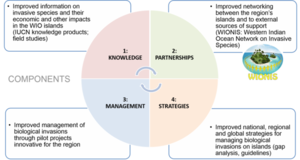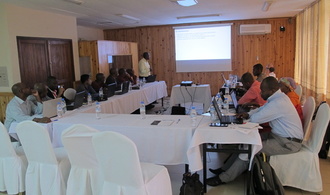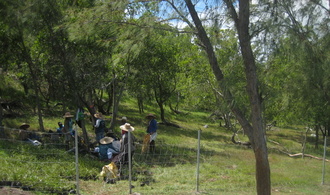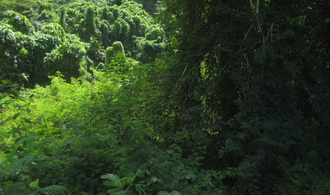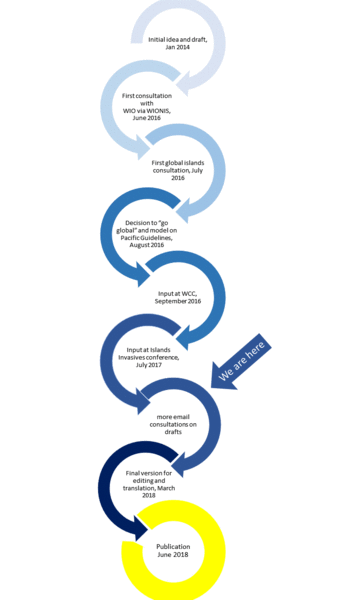The Inva'Ziles Project
Written by Modified on the
The Inva’Ziles Project (official title: Preparation and testing of a comprehensive model for preventing and managing the spread of invasive species on island ecosystems) is implemented by the International Union for Conservation of Nature (IUCN), funded by the European Union and hosted by the Indian Ocean Commission.
The project’s overall objective is to improve invasive species management systems of islands, in particular, those of the Western Indian Ocean (WIO), with the aim of reducing their impacts on communities and nature.The project began in February 2012 and is due to terminate on 31 July 2018. The project has four components, shown in the diagram below (click to enlarge):
KNOWLEDGE, PARTNERSHIPS, MANAGEMENT, and STRATEGIES.
The KNOWLEDGE component harnesses the expertise of our local partner organizations and of IUCN’s Invasive Species Specialist Group, to generate and compile knowledge on invasive species and their impacts in the region, mainly by means of studies and field projects financed by the project.These include:
- Compilation and review of legal, regulatory and institutional mechanisms for managing invasive species in the WIO islands
- Compilation of invasive species lists for the islands and countries of the WIO (made freely available on the Global Register of Introduced and Invasive Species, GRIIS)
- Risk analysis to identify priority species for management
- Analysis of introduction pathways, to identify priority pathways for management.
- Economic study in the Comoros, Mauritius (Rodrigues) and Seychelles of the costs of selected invasive species to local communities and economies, the costs of managing them effectively, and benefits of doing so, to create a powerful message to decision-makers.
The PARTNERSHIPS component launched WIONIS, the Western Indian Ocean Network on Invasive Species, and its email distribution list, in 2012.This network, together with multiple inter-island meetings and exchanges, constitute the project’s main mechanisms for increasing cooperation to tackle invasive species in the region. In addition, Inva’Ziles brings together national, regional and external institutions to collaborate and assist the target countries of the region to improve their management of invasives. The institutions working most closely with us include:
| Centre de coopération internationale en recherche agronomique pour le développement (CIRAD) | Institut National de la Recherche pour l'Agriculture, la Pêche et l'Environnement (INRAPE), Comores | |
| Centre National de Documentation et de Recherche Scientifique (CNDRS), Comores | Landcare Research, New Zealand | Pacific Regional Environment Programme (SPREP) |
| Conservatoire Botanique National de Mascarin (CBNM) | Plant Conservation Action Group, Seychelles | |
| Herbier des Comores | National Parks and Conservation Service, Mauritius | |
| Indian Ocean Commission | ||
| Ministry of the Environment, Energy and Climate Change, Seychelles | Dahari, Comores |
And the list of local and international institutions represented in WIONIS is much longer than this!
The MANAGEMENT component works mainly by helping national partners to establish innovative pilot projects in three target countries of the region, Comoros, Mauritius and Seychelles, with the aim of broadening the scope of invasive species management in these countries.
In the Comoros CNDRS leads a consortium of Comorian Institutions to compile an improved list of introduced species in the country, including plant surveys throughout the islands, and carry out a risk analysis of all introduced plants, for prioritization purposes. At the same time, these institutions are forming a national invasive species committee and plan to write the first national invasive species strategy and action plan for Comoros.
In Rodrigues Island (Republic of Mauritius), the Rodrigues Regional Assembly and Forestry Services are working with local communities to carry out an ambitious plan to control a highly invasive introduced tree, Acacia nilotica, and replace its dense spiny thickets by native forest (protected areas) and sylvo-pastoral systems (on community lands), by planting native species. The species planted include highly threatened species found only on Rodrigues, many of which were almost extinct (fewer than 10 individuals left), and which have been rescued by this programme.This is a fine example of government and communities working together on invasive species management, to the benefit of all.
In the Seychelles, we are supporting two projects. One is the first attempt in Seychelles to eradicate completely an established invasive plant from an inhabited island. Our partner the Plant Conservation Action Group, in association with local landowners, is attempting to eradicate the introduced spiny scrambler Acacia concinna, locally known as Rons, from the island of Mahé, and since it is only found on this island, this should remove it from the whole archipelago. Rons is only known from a dozen limited sites and does not appear to be producing viable seed, so there is still a chance to eradicate it before it spreads more widely.
Our second Seychelles pilot project is a novel programme to integrate the management of several invasive species at once, while at the same time monitoring the response of the native species and ecosystem, at the Vallée de Mai World Heritage Site on Praslin Island. Our partner the Seychelles Islands Foundation, which manages the site, is carrying out this programme to reduce the impacts of introduced rats, tenrec, ants and plants on some highly threatened endemic species, and on the ecosystem as a whole.
The STRATEGIES component aims to improve strategic planning and rational prioritization of scarce resources in the battle against invasive species, at both national and regional WIO levels. This component is tightly integrated with the other three. For example, the pilot project in the Comoros should lead, with technical and financial support provided by Inva’Ziles, to a national invasive species strategy and action plan. Inva’Ziles also provided input to the new Mauritius NBSAP. More broadly, Inva’Ziles is financing a gap analysis of national, regional and island plans relevant to invasive species management in the WIO, carried out by the Pacific Invasives Initiative. The aim is to identify areas of action that are essential for effective management but tend to be neglected in the region. And the final large and potentially globally influential elements this component is the production in several languages of a guidance document for invasive species planning and management on islands worldwide. Production of this guide is a consultative process, using WIONIS and many other invasives email distribution lists, together with face to face consultations at international meetings. The timeline of the process of producing the new guidelines is shown in the diagram below (click to enlarge).
For further information, contact the Inva’ZilesProject Coordinator.
Here you can find all Inva’Ziles Project newsletters:
Acknowledgments
Many thanks to Henri Brouchoud, Olivier Hasinger and especially Katharina Lapin for their assistance with setting up this WIONIS website.
The Inva'Ziles Project is supported by the European Union



